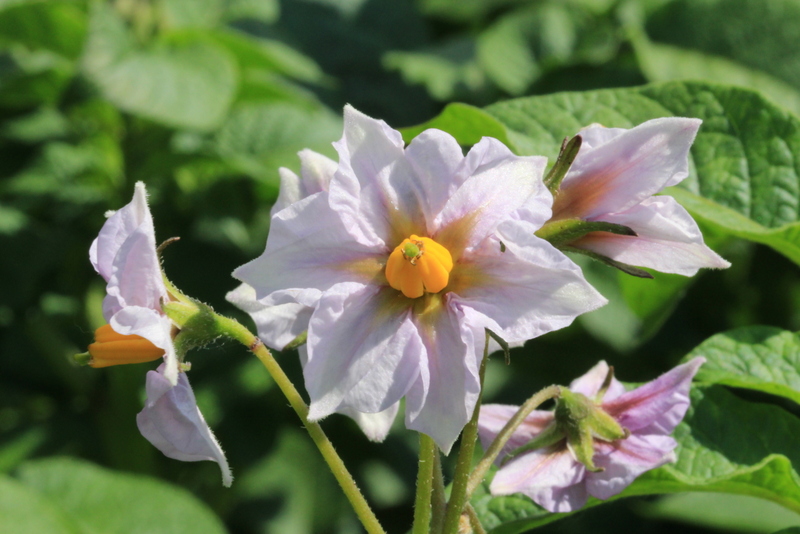Potato Extension
Potato Diagnostics
Questions about your potato crop? Use this form to submit to NDSU/U of M potato diagnostics. If the problem can be diagnosed through this form, a response will be provided. If we need a physical sample we will request a sample be shipped for further diagnostic identification in a laboratory or request a field visit. Please fill out the requested information and attach a minimum of one picture of the problem (more pictures will help with diagnostics).
US Seed Potato Acres Increased 3.8%
US potato seed acres saw in increase in 2014. The largest increase was in North Dakota, Colorado, and Oregon.
Identifying Surface Blemishes on Potato Tubers
The primary blemishes fresh market potato growers face today include black dot, black scurf, scab, silver scurf, unattractive skin color, malformed tubers and other unknown blemish problems. A new webpage, Potato Tuber Blemishes Understanding & Diagnosis, provides some information on these blemishes.
New Focus on Potato: Root Lesion Nematode on Potato
This presentation will help consultants, growers, and other practioners scout and manage root lesion nematodes, the most common nematode pest in most potato fields. This presentation will explain when to be concerned about root lesion nematodes, the interaction of root lesion and Verticillium dahliae for the potato early dying disease, and the options available to maintain population densities of root lesion nematodes below damaging levels. The life cycle of root lesion nematodes will be covered including their remarkable ability to persist without feeding. By the end of this presentation, the practitioner should know more about the root lesion nematode life cycle, be aware of their patchy distribution in the field, understand the importance of managing nematodes throughout the entire rotation, and have a general knowledge of the tools available to do so.
Blightline September 8
No new late blight has been reported in ND, MN or MB the past week. The only confirmed late blight this season was in central MN in processing potatoes, and that was late in the season; fungicides applied and fields killed to reduce late blight spread and severity. We have seen a few samples with bacterial soft rot due to some scattered late August rains, and some common scab. Otherwise, our crop looks very good and is of high quality.
Aphid Alert for week ending Sep. 5
A marked drop in vector numbers with fewer traps reporting as the season closes down. Nate reports that there are still a lot of soybean aphid (87), bird cherry oat (29), and corn leaf (28). Green peach aphids were also captured this week at Forest River, Gully, and Hallock.
Managing Fungicide Resistance in Potato
This presentation will help potato growers, consultants, agribusiness personnel and others associated with the potato industry in North America understand and manage problems associated with fungicide resistance. This presentation will discuss the different modes of action of fungicides currently registered for use on potatoes in the USA, the risks of developing fungicide resistance and practices to minimize the development of fungicide resistance problems in production fields.
Blightline August 28, 2014
Late blight has been reported in Benton County, MN, in commercial potatoes and been moving into additional fields in this area as a result of rains, high dew points, and cool weather. Growers in central MN should be scouting fields, applying fungicides to reduce tuber infection and killing fields to prevent further movement. Recommended fungicides to reduce tuber infection include Gavel, Omega and Ranman. Late blight is an explosive disease that can spread quickly in cool wet weather so it is important to keep the foliage protected with fungicides late in the season. We would appreciate receiving samples of late blight for genotype identification.
Blightline August 25, 2014
The late blight reported in Becker County was negative after laboratory testing. Growers should continue to apply protectant fungicides for both late blight and early blight and continue to scout for late blight. Morning dews that form this time of the year provide free moisture necessary for late blight infection. Late blight is an explosive disease that can spread quickly in cool wet weather so it is important to keep the foliage protected with fungicides late in the season.
Aphid Alert for Week Ending August 22
Aphid vector numbers were up for A THIRD WEEK IN A ROW! Probably because the temperatures last week were excellent for aphid reproduction and numbers were increasing. This may well have led to an increase in winged aphids, resulting in higher trap catches. Trap catches increased at a number of locations over last week and decreased in some others. Numbers were up in Ada, Erskine, Hallock, Hoople, Langdon, Linton I, Perham, Staples, Stephen and Walhalla and down at other sites. Approximately 80 more aphids were recovered overall from all traps compared to last week.
Document Actions





